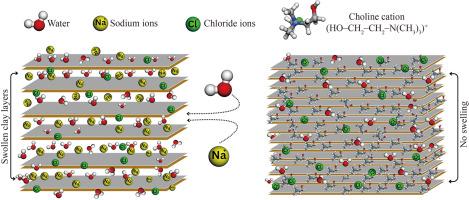Mitigating clay swelling and permeability loss in thermal EOR with a quaternary ammonium clay stabilizer under high-temperature low-salinity conditions
IF 3.6
引用次数: 0
Abstract
Clay swelling and fines migration pose significant challenges to thermally enhanced oil recovery (EOR) operations, particularly in clay-rich formations. This study systematically investigates clay swelling behavior and permeability impairment under high-temperature, low-salinity (HTLS) conditions and evaluates various inhibition methods to mitigate formation damage. To ensure realistic analysis, data and materials from a field with similar issues in Kazakhstan were used. Static/dynamic swelling tests demonstrated that a quaternary ammonium-based inhibitor consistently provided superior clay stabilization through effective ion exchange and surface charge modification mechanisms. In distilled water at 100 °C, inhibitor-treated samples maintained 48.89 % of their original permeability, while untreated samples exhibited severe damage, retaining only 17.05 %. Additionally, this chemical inhibitor significantly lowered the critical salt concentration (CSC), effectively stabilizing clay at 4920 ppm salinity compared to 7380 ppm required without treatment. Scanning electron microscopy (SEM) imaging corroborated these results, revealing that inhibitor-treated clay maintains a compact and coherent structure, in stark contrast to the pronounced swelling, delamination, and structural deterioration observed in untreated clay samples. Nevertheless, this quaternary ammonium-based clay stabilizer presents a robust and promising solution for reducing clay swelling-induced damage, sustaining reservoir permeability, and improving thermal EOR performance in swelling-prone formations.

在高温低矿化度条件下,用季铵粘土稳定剂减轻热采收率中粘土膨胀和渗透率损失
粘土膨胀和细粒运移对热采收率(EOR)作业构成了重大挑战,特别是在富含粘土的地层中。本研究系统地研究了高温低矿化度(HTLS)条件下粘土的膨胀行为和渗透率损害,并评估了减轻地层损害的各种抑制方法。为了确保切合实际的分析,使用了哈萨克斯坦一个具有类似问题的实地的数据和材料。静态/动态膨胀试验表明,季铵盐基缓蚀剂通过有效的离子交换和表面电荷修饰机制,始终具有优异的粘土稳定性。在100°C的蒸馏水中,经抑制剂处理的样品保持了48.89%的原始渗透率,而未经处理的样品破坏严重,仅保留了17.05%。此外,该化学抑制剂显著降低了临界盐浓度(CSC),在4920 ppm的盐度下有效地稳定了粘土,而未经处理时的临界盐浓度为7380 ppm。扫描电子显微镜(SEM)成像证实了这些结果,显示抑制剂处理的粘土保持了致密和连贯的结构,与未处理的粘土样品明显的肿胀、分层和结构恶化形成鲜明对比。尽管如此,这种季铵盐基粘土稳定剂在减少粘土膨胀引起的损害、保持储层渗透率和提高易膨胀地层的热采收率方面表现出了一种强大而有前景的解决方案。
本文章由计算机程序翻译,如有差异,请以英文原文为准。
求助全文
约1分钟内获得全文
求助全文

 求助内容:
求助内容: 应助结果提醒方式:
应助结果提醒方式:


